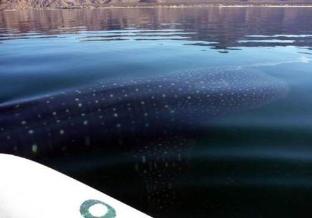Published in the Ocean Watch column, Honolulu Star-Advertiser © Susan Scott
November 21, 2011
I did it off western Australia years ago on an organized tour. Last year I did it by myself in the northern Sea of Cortez. A week ago I did it in the southern Sea of Cortez with my husband, Craig.
When it comes to swimming with whale sharks, I will never get enough.

Photo by Susan Scott
Whale Shark.
Most people blanch when I say I swam with sharks the size of a bus, but these are not your average sharks. Huge, yes, but like the other marine giants, baleen whales and manta rays, whale sharks eat only plankton.
Whale sharks are the biggest fish in the world, growing to a maximum length of 55 feet, yet these fish eat some of the tiniest plants and animals in the ocean.
The fish swims forward with its 4-foot-wide mouth agape, sucking in plankton-rich water. As the water exits through five pairs of gill slits, sieves in the shark’s gills filter out the food. The shark’s efficient strainers trap seaweed, krill, fish and larvae as small as 1 millimeter, about as small as the human eye can see.
Whale sharks are worldwide roamers that can show up any time, any place in tropical and subtropical waters. People occasionally spot these fish in our waters, but their appearances in Hawaii are unpredictable.
In several nutrient-rich areas of the world, however, whale sharks are such regular visitors that sightings are practically guaranteed.
Springtime off Australia’s west coast is one of these places, as are the sharks’ annual spring and fall migrations to the remote Bahia Los Angeles in the Sea of Cortez, or Gulf of California.
On this trip I also learned that a school of whale sharks spends its winters just a mile or so off La Paz, the capital of Baja California Sur.
Craig and I had planned to sail north to Bahia L.A. to swim with the whale sharks, but the wind did not cooperate.
Instead, we sailed south to La Paz, where a fellow sailor gave us good news.
“You can swim with the whale sharks right here. They’re only a couple miles away.”
In a flash we were puttering our little rubber dinghy as directed.
An hour later, as promised, an enormous fin appeared on the surface of the calm water.
Whale sharks’ back fins don’t have that heart-palpitating shark fin shape. They’re round-topped, friendly-looking.
Striking white dots and dashes decorate the shark’s blue body in patterns unique to each individual, handy in studying this endangered species.
We human swimmers can’t keep up for long with the sharks’ 3-miles-per-hour glide. But the fish is constantly turning while feeding, and if you’re lucky it will turn toward you.
We were lucky. For a few glorious moments the shark allowed us to look into its gaping mouth and tiny eyes. Craig and I then swam alongside this whale of a fish with its entourage of silvery fish and stuck-on remoras.
When my friends arrive this week, I’m going to do it again.